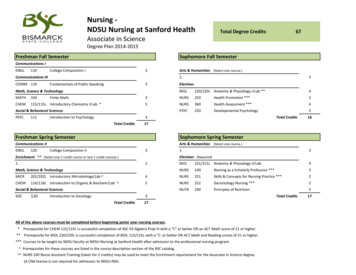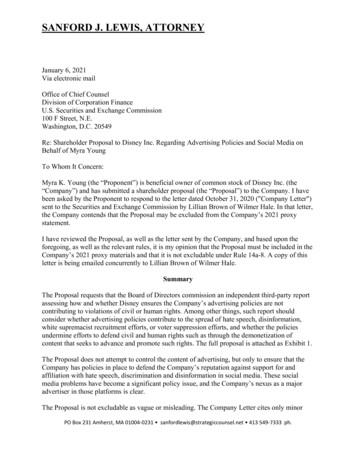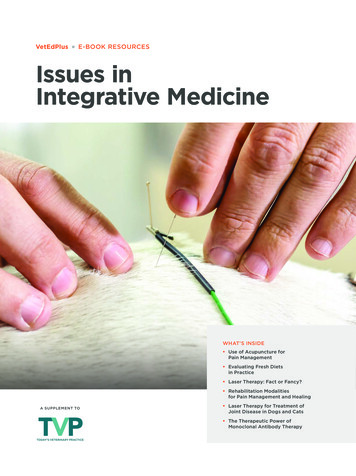
Transcription
Integrative Essentials:Pre-Treatment
Welcome to Integrative Essentials: Pre-Treatment. As you begin treatment, your medical teamwill support you throughout and you can learn skills to be an active participant in your healingprocess. In this program, you will learn to relax and imagine your own healing which can helpyou thrive through treatment.Treatment will look different for everyone. Surgery, chemotherapy (chemo) or radiation may beused alone or together.You can begin to: Understand the effect stress has on the body and mind Explore why you want to get better Discover what healing looks like for you Create a strategy to communicate with your medical team Learn tools to help reduce stress
Understand StressThis program will assist you with tools to deal with stress as you go through cancer treatmentand beyond. Being diagnosed with cancer is stressful so a major goal of this program is to learnhow to manage those stressors. Stress is the perception of a threat to your physical or psychologicalwell-being and the belief you do not have the skills to manage. What that means is: Your body or mind decide that something dangerous is happening or is about to happen to you. Your body or mind think you do not have the tools or the tools you have are not strong enoughto stop the danger.During stress, the sympathetic nervous system (SNS) kicks into gear. Perhaps you have heard fightor flight used to describe how the SNS works. During a stress response, the fight or flight systemis engaged, hormones are released into the body and the body is given extra energy to run away orto stay and fight. This response has kept humanity safe for thousands of years. To keep the humanrace going, we needed to remember that a saber tooth tiger would bite if we let it get too close.Today, stress responses are helpful to boost reflexes during a car accident, alert us during publicspeaking, or catch a toddler as they leap off a table. Short bursts of these stress hormones are alsogood to strengthen your immune system (Dhabhar, 2014). However, it is not helpful to live in chronicstress. When our ancestors ran away from a saber tooth tiger thousands of years ago the SNS gavethem enough energy to run away, climb a tree, and let the threat pass. After the short burst ofenergy from the stress response they went back to living a simple life. These were necessary andhelpful short bursts of stress. Unfortunately, most modern humans live in a state of chronic stress.Whether it is busy schedules, the 24-hour news cycle, or the demand to achieve, our culture promotesa state of chronic stress. When the body is chronically stressed, it is like an over-worked engine.The systems of the body stay in high levels of stress for long periods of time and your engine controlsystem cannot keep up. It becomes depleted, is forced to run on fumes and then no longer has theenergy to keep the body healthy and working well. Research confirms long-term stress has anegative impact on the body (Salleh, 2008).Because of this negative impact, it is important to take time to reduce stress, especially when you areabout to begin treatment for cancer. Your body and mind need the time to shift into the relaxationresponse known as the parasympathetic nervous system (PNS.) That is where your natural healingabilities are activated, which can work with your treatment to get rid of any abnormal cells.Things you hear about treatment can increase the stress response. Stories from friends or familymembers, on-line research, or support group chat rooms can focus on the negative aspects oftreatment. Positive treatment stories are usually not shared or, if they are, not what themind remembers.Remember, your brain is set up to recall threats in order to survive. Your mind holds on to thenegative (which your brain views as a threat) while dismissing the positive (Hanson, 2014). It drawsconclusions using the negative information before you even have the experience! In order to havea helpful, uplifting outlook on your treatment, you must practice just that. If you do not give themind a chance to realize your treatment can go well and you can feel comfortable and thrive, thenthe mind may think only negative outcomes are possible.
The quality of our thoughts are interwoven with our emotions and behaviors.ThoughtsWhat we think affectswhat we feel and do.EmotionsBehaviorWhat we feel affectswhat we think and do.What we do affectswhat we feel and think.You did not have any control over being told you have cancer, but you do have a choice of howyou go through this process. You can choose to take steps to reduce your stress. You can choose tothink uplifting thoughts and see your treatment as helpful. You can choose to honor feelings as theycome up and utilize the tools you have to help them shift. You did not choose to have cancer,but you can choose to take part in your healing process.Partnering With Your Medical TeamCreating a partnership with your medical team goes a long way in feeling a sense of care and safetyduring treatment. In fact, your outcomes and symptoms can be improved greatly if there is a senseof mutual respect. It is helpful to know that your team is listening to your wants and needs.(Chandra et al., 2018).Do you feel you and your team are working well together? Do you feel encouraged to discuss yourtreatment? If it is important to you to be a part of decision making, do you feel included?4
To begin answering these questions, it is helpful to have an understanding of what type of role youwould like to take in the decision-making. What type of role would you like to play throughout yourtreatment? Are you a person who likes to have all the information about your treatment in order tomake the best decisions for you? Or does hearing all of the details create more stress and anxiety?If you are a person who wants all of the information: Write down all of the questions you want ask your doctor. Have a notebook for your questions or put notes in your phone– Bring to your medical team and do not be afraid to ask! If possible, bring a support person to be your “second set of ears” or ask if it is ok to recordyour appointment so you can refer back to the information given.If you find that you are not someone who likes to hear all treatment details, you could ask a familymember or friend who you trust to get the details you do need.Whether or not you like hearing in-depth information about your treatment, your medical teammust tell you about side effects or problems that could occur during surgery, chemotherapy orradiation. Hearing these side effects are helpful to some, but can create more anxiety and fear forothers. Listen to what your medical team needs to communicate and then ask “Will you pleaseshare with me the benefits of having this procedure or treatment?” You can choose what informationhelps boost your confidence and set aside information that might cause stress.Think About What Healing Means to YouConcepts such as “getting better”, “experiencing healing” and “being well” mean different thingsfor different people. It can, but does not have to mean “cured”. It is how you describe thrivingthrough treatment and the rest of your life.What might “better”, “healing”, “wellness” look or feel like to you? Go to your Integrative Essentialsworksheet to write your ideas.It can be helpful to know why you want to get better. This may seem silly at first. But how would youanswer? Why do you want to get better? Yes, the easy answer might be “to live” or “to be healthy”,but why do you want to live or be healthy? To spend more time with your friends or family? To beable to do your favorite hobbies? To do the work you were called to do? What makes those thingsimportant to you? Write these on your Integrative Essentials worksheet.Wellness is different for everyone. Understanding what it looks like for you and why it is importantcan be helpful to know as you go through treatment.5
Integrative Essentials: Pre-Treatment ToolsThe Integrative Essentials steps for being an active participant in your treatment are:1. Spend time in relaxation by listening to the calming relaxation track2. Allow people to support you with uplifting intentions.3. Prepare intentional messages for your treatment.Step 1: Listen to the Calming Relaxation PracticeThe first step is to take time for intentional relaxation and healing images every day. You will begiven an audio of a relaxation practice made as part of the integrative essentials program.For surgery: Begin practicing now, once per day 3-7 days before your surgery, practice 2 times per dayFor chemo or radiation: Listen to this track once per day Listen 2 times a day if you are having extra anxiety, stress, or worry.Your caregivers are anyone who supports you throughout treatment. A caregivermay be a spouse, parent, sibling, your children, or friends. Ask them to help remindyou to carve out time to listen to your relaxation track. You might even ask themto join you in listening! It can be helpful to have them imagine your treatmentgoing well, too. A Caregiver Support relaxation track is also available.Studies show that taking time to relax can help boost the immune system, reduce nausea and helpmanage pain (Huddleston, 2013). Relaxation is what your body and mind need to switch from thatfight-or-flight and into the relaxation nervous system. Remember, the relaxation portion of yournervous system is where your body has the opportunity to rest, rejuvenate and to activate the naturalhealing abilities you naturally possess. The provided audio is to give you an intentionally guidedpractice. In this guided practice, you will use body awareness, spend time in your healing place,tap in to an “inner strength”, personalize healing images, and practice gratitude.Much of this relaxation practice asks you to use your imagination. Children use their imaginationall the time, but are often not encouraged to continue as they grow. Your imagination is still there.It is like a muscle to be strengthened.6
Everyone imagines in a different way. If you have any prior experience with guided practices suchas these, you might have heard the use of the word visualize. This word visualize can sometimes befrustrating because not everyone can visualize. But everyone can imagine. Observe how you imagine.Is it: Visual Have an inner knowing Do you hear sounds Hold the concepts in your mind Feel sensationsClose your eyes and think of a red fire truck. Do you see the fire truck? If you do not see it do youhold the idea of a firetruck in your mind? You know that it is red, has at least four tires, lights maybe flashing, there is a loud siren, and ladders and hoses attached. See? You can imagine the fire truckin your mind!Anyone can do this relaxation practice. No experience required! Just close your eyes and listen.You do not have to work hard at trying to feel a certain way- whatever happens, happens. Simplymindfully observe it.Body AwarenessYou begin by bringing your awareness through your body, and you do this by simply listening tothe audio and following along. You will be guided to allow a sense of comfort to travel throughyour body. Everyone experiences “comfort” differently. For you, it might be relaxation or calm.You might experience a heavy or light feeling, or be filled with a color that represents comfort.Again, there is no wrong way to do this- just listen and notice what happens.Healing PlaceNext, you will be prompted to imagine yourself in a comfortable, safe and healing place. This mightbe a place you know very well, or a place you know of (Rossman, 2003). It might be a brand new placeyou have never been to before. It does not matter, as long as this place feels safe to you and has ahealing quality to it. You might know exactly what is healing about it, but you might not.Go to your Integrative Essentials worksheet to take some notes about your place, but know that whatcomes to you when you listen to the relaxation track might be different from what you originallywrite down. Trust that your mind will take you to exactly where you need to be.When you are there,use all of your senses to create a full picture for your mind. When you are in this place, even if it isfamiliar, notice the things you see, hear, smell, and feel. Notice how safe and comfortable you feelin this place.7
Tap in to an “Inner Strength”Inner strengths might also be referred to as positive emotions. We know that experiencing emotionsor thoughts that are uplifting can create a sense of well-being, resilience and connection. Whatinner strength would you like to create? What would be most helpful now? You might not feel likeyou embody this inner strength at the moment, but you want more of it as you go throughtreatment. Maybe you have experienced it in the past. Perhaps you know you have this inner strengthright now, but you want to feel even more of it. In any case, we all have these strengths within us,we just need to remember that they are there and allow it to activate within!Choose what inner strength you would like to cultivate within you during your treatment. There’sno need to over think it. Just choose which one feels best to you and write it on your IntegrativeEssentials worksheet. Here are some ideas: Joy Hope Awe Gratitude Pride Love Serenity Amusement Contentment Interest Inspiration OtherOnce you have chosen your inner strength, write about a moment where you have had that strengthor would represent that you are living it now. There is space on your Integrative Essentials worksheetto make these notes.Your Healing ImagesThe next step is to spend some time imagining that your treatment is going and has gone very well.These images will vary depending on your type of treatment. You will even be able to personalizesome of these images because the words and moments that you provide will be the most effective!When you imagine your treatment going well, you are giving your mind the opportunity tounderstand that thriving through treatment is a very attainable goal.For surgery: You will be guided through an image that your expert medical team is well rested, ready to dowonderful work for you, and that your surgery has gone very well. Simply listen to the audioand follow along.For chemo and radiation: Create an image that shows treatment is healing for you and doing exactly what it should.The image may take place in the treatment room or somewhere else. You will choose what isimportant to you. As you use all of your senses to create this image, you will also continue tobe filled with your inner strength. You might even imagine talking to a loved one (or thinkingto yourself ) to express how great you feel and/or how well your treatment is going.8
An Image for Everyone:Create a moment that represents you are completely healed from treatment. Look to the future,as far out as you would like to look. Imagine that you are doing something you love to do that iscalming or relaxing. Or perhaps choose to imagine yourself doing something that is energizing,exciting and meaningful or something you are looking forward to. Throughout this moment, youare sensing your inner strength.9
GratitudeYour session ends with a moment of gratitude. According to Harvard Medical School,experiencing gratitude: Makes it easy to recognize a good experience Cultivates resilience Supports respectful relationships Makes you happierThis is a time to create a sense of kindness and compassion for your medical team, treatment,and your body. Feeling kindness, compassion and gratitude aids in overall wellbeing.It might be easy to understand being grateful for your medical team and even yourtreatment. But have gratitude for your body? This is a foreign concept to many.After a cancer diagnosis and during treatment, it can feel even more challenging.It’s understandable to feel this way, but think of this: You ask someone to dosomething for you, but instead of saying thank you and giving praise for the effortthey put forward, you tell them they are awful, horrible, that you want them to beany other way than the way they are. Would you ever treat someone that way?Do you find yourself talking to your body that way? Having a nurturing and caringrelationship with your body is good for your overall wellbeing.10
Step 2: Allow People to Support YouIn Integrative Essentials: Pre-Treatment, you will ask people to think of you the day of treatment.You may ask for uplifting intentions such as: Prayers Positive thoughts Healing energy Bright white light OtherThere is evidence that people who know others are sending them positive thoughts get better fasterand have fewer complications (ScienceDaily, 2007). Record the uplifting intentions you would like toreceive in the Integrative Essentials: Pre-Treatment worksheet.Ask your family, friends, co-workers, church groups, club members, fishing buddies, book clubmembers, and others to think of you. Some people prefer to keep their treatment private. In thatcase, perhaps ask family or a few close friends to help you with this step. You may be surprised howmany people would be willing to help you in this way.There are many ways you can create your support team. You could call or text people directly.Or send an email or post a message on your CaringBridge site if you have one. You might makea private Facebook group and invite people who you think would be open to thinking of you theday of your treatment.If you are preparing for surgery, ask them to send you these thoughts early in the morning beforeyour surgery begins, if possible. You most likely do not know the time your surgery will begin asof yet, but you can simply ask your support group to send you the thoughts bright and early. Yourchemo or radiation start times might change, so you might decide to simply share the date withyour group and ask for uplifting intentions any time that day.If organizing this support group feels too overwhelming, ask someone to help you.They can share the type of intentions you would like to receive along with the datesand times of you treatment.11
Step 3: Intentional MessagesMany people about to begin treatment for cancer experience thoughts of fear or worry. This is normal.Crafting and using intentional messages can be one way to bring yourself from a state of fear andworry to a state of calm and relaxation.Your mind is always taking in messages. In times of stress the mind is very open and can be easilyswayed. Chronic long-lasting negative thoughts will lead you to see the world in a negative light.But you can start to change the script by bringing your thinking to a more neutral state. As you shiftyour thinking, your experience may become more positive (Hanson, 2014).Again, it is very important to note that you do not need to be positive all the time. Everyone hasdays when they are more sad, angry, worried, or afraid. It is ok to feel these things! It is when thoughtssuch as “this is going to be so horrible,” “I can’t do it,” “I’m not strong enough,” or “this is poison”are allowed for a prolonged period of time that problems result. Thinking these thoughts over andover again, especially when there is extra stress, makes the brain believe it is true and that it is theonly truth that exists. Would you say those types of things to a friend or family member when theywere under stress? No, you would not!A tool that can be used to help flip that negative script are intentional messages. When negativethoughts fill your mind about treatment, you will learn to lean on more positive thoughts. If you arepreparing for surgery, these intentional messages will be read to you as you are under anesthesia.If you are preparing for chemo or radiation, you will use these intentional messages in momentsof worry, fear, or stress.Intentional Messages for SurgeryDuring surgery, although you are not conscious or aware of what is happening, general anesthesiadoes not block out the part of your brain that hears. Therefore, it is important that what is saidaround you is as helpful and supportive as possible (Rosendahl et al., 2016). Hearing intentional statementsat the beginning and end of your surgery is very effective. By working with your medical team,you can use these statements to create a helpful mindset.When you arrive at the hospital on the day of your surgery, bring along your “Intentional Messagesfor My Medical Team” pages. Give a page to your surgeon when they come in to see you beforesurgery begins. Keep an extra copy for yourself. Anyone can read these statements to you duringyour surgery. It might be your surgeon, anesthesiologist, nurse, or nursing assistant who reads it toyou- it does not matter.As you are going under anesthesia, someone from your medical team will say:“We are here taking care of you. Let yourself be in your safe, healing place.After surgery you will be comfortable and you will notice your healing hasalready begun. We are here taking care of you.”12
Toward the end of surgery they will say:““Your surgery has gone very well.“Your digestive system isworking exactly as it should.All of your body systems are strong.They will also read to you an intentional message you create. When creating your personalizedmessage, consider these questions: How would you like to feel after your surgery? What goals doyou have following your surgery? Is there a short prayer you would like to hear? Use some of youranswers to write your own intentional message.You can use this intentional message in moments you experience worry or fear. Please create yourintentional message on your “Intentional Message Guide for My Team” page.13
Intentional Messages for Chemo or Radiation:When you use intentional messages for chemo or radiation, say them to yourself every day, especiallywhen you feel any stress, worry, or fear about your treatment. They can be repeated out loud, silently,or you could write them down. Everything about these statements should be uplifting, positive,or neutral, and write them as though they are happening right now. Remember, focusing on positiveor neutral thoughts and statements can have a greater impact on your body and overall well-being.Feel free to use just one or all of the prompts below. You might consider writing these statementsand placing them somewhere you can see them every day.You can share this information with your family and medical team (especially your medical team withyou in your infusion room or in radiation). How would you like others to refer to your treatment?What kind of environment would you like them to help you to create in regards to your treatment?The messages you hear about and during your treatment can affect your experience, so share theseintentional messages with those around you.Intentional Messages for chemo or radiation:To begin, do 2 to 5 rounds of square breathing (found later in this guide). Then say or write:I have chosen this treatment to: Help Nurture Heal Other:I am(write how you want to feel)Write any other goals as an intentional statement. Fill in your messages on your IntegrativeEssentials worksheet.Congratulations, you have taken helpful steps to prepare yourself to spend time in relaxationand be an active participant in your treatment! You will: Listen to the relaxation track, using your healing images. Listen at least 1 time each day,2 times if you are having a particularly stressful, worried or anxious day, or if you are about3-7 days away from surgery. The more you do this practice, the easier it will be to activatethe relaxation response! Ask a group of people to send you uplifting intentions the day(s) of your treatment(s). Prepare and use your intentional messages. If having surgery, place your Intentional MessageGuide for My Medical Team sheets in a place where you will remember to bring them the dayof your surgery. If preparing for chemo or radiation, the more you repeat your intentionalmessages, the better!You now have many tools to utilize to promote healing and wellness within your body and mind.Use these tools every day to be an active participant in your treatment. Your body, mind and spiritwill thank you!14
Other Tools for Your Stress-Reduction Toolbox: Square breathing Exercise Sleep hygieneSquare BreathingBreathing can have a great effect on the mind. The breath not only acts as an anchor to the presentmoment, but can also help you create focus, energy, or calm. It can help give space between you andunhelpful thoughts. One easy breathing practice is called square breathing. Square breathing canhelp create calm and balance in the mind, help you get to sleep, and reduce treatment symptoms.Use this breathing practice before you state your intentional messages for chemotherapy or radiationor any time you feel stress, worry or anxiety.To practice square breathing: Inhale Pause your breath Exhale Pause your breathCount the length of each step in order to keep them equal. For example, silently count to fouras you inhale, count to four as you pause your breath, count to four as you exhale, count to fouras you pause your breath. You can choose any number, just keep the count even. Practice 2 to 10rounds or set a timer and practice for 1 to 5 minutes, as often as you tch an instructional video about squarebreathing by typing in the YouTube linkinto your search bar, or you can hold thecamera on your smartphone or tablet upto the QR code to be taken directly tothe link.15
ExerciseExercise is a great way to prepare your body for treatment, manage symptoms (particularly reducefatigue), maintain strength and functional mobility, and assist in balancing mental health. If you arenew to exercise and are currently in or have just concluded treatment, start out by exercising lightly.Suggested activities include walking, using a stationary bike, light weight lifting, yoga, or other bodyweight exercises. Always ask your doctor for exercise recommendations and restrictions, but hereare some general guidelines:Surgery:Enhanced Recovery after Surgery (ERAS) provides a guideline for best outcomes after surgery.It is advised to be active for at least 30 minutes per day, for at least 5 days before surgery if youare able. Right after surgery, it is important to move your body by gently moving your legs in bed,sitting up, and even getting up to walk. Moving after surgery is one of the best ways to begin yourrecovery. Listen to your medical team, they will assist you with this.When you get home after surgery, continue to be gently active but be sure to follow your doctor’sguidelines. For example, you may be given a limit of what you can lift such as no more than 10 poundsfor at least 6 weeks after surgery. This is a great time to walk and do exercises you may have beengiven by physical therapy.Chemotherapy or Radiation:According to the American College of Sports Medicine, it is recommended to build up to 150minutes of exercise per week while in treatment.If you have already been exercising before your diagnosis, continue doing so but listen to your body.There may be some days you need to do a gentler form of movement. Continue to adhere to anylifting restriction if you just had surgery and wait for your doctor’s approval before you liftanything heavy.If you did not exercise before your diagnosis, start at a place that is manageable for you. You mightconsider beginning a walking program or doing a gentle yoga practice for 1 to 15 minutes per day.Begin to lengthen the amount of time you are exercising as you feel ready (Mctiernan et al., 2019).Consistency is key whether you are an experienced exerciser or are just beginning. Try to moveyour body every day, even if it is only for a few minutes!16
Sleep HygieneSleep is very important for the health and wellbeing of your body and mind. During this neededrest, your body shifts into the relaxation (healing) part of your nervous system. Sleep can sometimesbe disrupted due to the stress that comes along with a diagnosis, due to medication, or physicaldiscomfort. “Sleep hygiene” is a phrase used to describe good sleep habits. Here are some sleephygiene tips if you are having difficulty with sleep: Go to bed and wake up at the same time every day. Create a sleep routine. Avoid caffeine past 2 pm. Avoid alcohol at least 2 hours before bed. Do your best to avoid naps after 2 pm. Avoid blue light from screens before bedtime. Avoid a heavy meal right before bed.17
Relaxation Tracks for Integrative EssentialsListen to these by viewing the YouTube link or hold the camera on your smartphone or iPad upto the QR code.Before Surgery RelaxationAfter Surgery u.be/bd2wISiapPsRelaxation for Chemotherapy or RadiationRelaxation for Caregivers:https://youtu.be/jF uVnkU7yEhttps://youtu.be/yNl-HTNEA3A18
Integrative Essentials Worksheet for SurgeryWhat might “better”, “healing”, “wellness” look or feel like to you?Why do you want to get better? Yes, the easy answer might be “to live” or “to be healthy”, but whydo you want to live or be healthy? To spend more time with your friends or family? To be able todo your favorite hobbies? To do the work you were called to do? Write why here: My Relaxation PracticeMy personal healing place (what would you see, hear, smell, feel in this place):My chosen inner strength:Have you experienced that inner strength in the past? Write a few notes about that moment andhow you felt during it. If you have not experienced your chosen inner strength, jot down a few notesof how you would imagine you would act or be if you did embody it:Create an image of yourself in the future that shows you are completely healed from surgery andyou have an acceptance of that healing. Write about it here:Allow People to Support YouThe type of uplifting intentions I would like to
Integrative Essentials: Pre-Treatment Tools The Integrative Essentials steps for being an active participant in your treatment are: 1. Spend time in relaxation by listening to the calming relaxation track 2. Allow people to support you with uplifting intentions. 3. Prepare intentional messages for your treatment.










